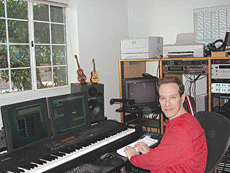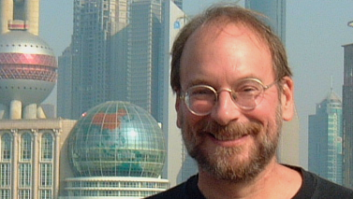
Craig Sharmat surrounded by his computer-centric composing rig
Kids don’t usually launch their music career composing or arranging; those gigs evolve over time. Craig Sharmat (www.scoredog.tv), for example, grew up in Irvington, N.Y., playing guitar in high school bands. After studying at Syracuse University and the University of Arizona, he settled in California, graduated from the Guitar Institute and headed to Las Vegas. Lounge and showroom gigs (he backed Englebert Humperdinck!) eventually grew old, so Sharmat headed back to L.A. Soon, he was on the road with Ronnie Laws and Randy Crawford.In the mid-1980s, he landed his first scoring gig for Disney’s Kids Incorporated and hung onto it for three years. Bitten by the composing bug, Sharmat hung up his road shoes and began looking for scoring assignments. These days, the guitarist, who admittedly has limited keyboard chops, is an A-class orchestral emulation specialist. When he’s not composing music for America’s Most Wanted (a gig he’s held for 10 years) and animation and other nationally broadcast shows, Sharmat can be found in his home studio churning out show pieces for several major sample libraries, including the Vienna Symphonic Library and Sonic Implants. He has recently worked with trumpet player Rick Braun on game sound arrangements for Sony.Computers, of course, are now spread throughout Sharmat’s studio. His current console-less rig includes four PCs and a 2GHz dual Mac G5. “I mix entirely within Digital Performer or Logic,” Sharmat says. “Logic 7 is excellent — there are some new EXS sounds that are really good — and I’m starting to make it my main sequencer.“Once you start getting into large track counts — I typically run up to 60 and sometimes even more — it’s critical to set up templates that you can use over and over again,” he advises. “It’s also important to decide which libraries you prefer for different tasks. With strings, I’ll have multiple tracks for all sections. Take the cello section: I’ll set up tracks for staccato and legato cellos, and another that can handle runs. The Sonic Implants library is my overall favorite straight out of the box; it has the most natural sound. The samples are placed in the proper positions with just the right amount of hall ambience. I use the EastWest Quantum Leap Symphonic Orchestra for a number of things — mostly when I need power. I also use the SAM libraries. The new True Strike percussion library is my go-to percussion source. I also like their brass; they come with more effects than any other library.“I use VSL a lot because their articulations and tools are so well-thought-out, but when I apply reverb, the work needs to get a little more detailed. Once it’s set up, though, I don’t have to think about it again. With VSL, I need to create the early reflections of the stage. I’ll take a convolution reverb that has different stage distances and apply them on a per-section basis. Just as you’d hear them in a hall, I set up the strings closest to the listener, then the winds, brass and finally the percussion. This is how I create depth in a mix. Then I’ll put a large room on top as I would with the libraries that have built-in reverb.”The other computers in Sharmat’s studio are Lightpiped into his G5 mixing station. “Everything goes through a MOTU 2408 Mk III. I have two other MOTU devices: a 1224, which I use for analog inputs, and a 2408 Mk II for other audio inputs. I’ve eliminated most of my MIDI devices by setting up an Ethernet network and using MIDI Over LAN.” Sharmat has had little call for surround mixes, holding onto a pair of Event 20/20s. “I’ve gotten to know how the mixes I create on the 20/20s will translate, and they work well for me.”As difficult as it has been to capture orchestral sections’ expressive potential, sampling solo instruments to yield satisfying results has been more difficult. Sharmat is quite partial to the Synful modeling device. “They’ve done a great job modeling these instruments and I’ve begun to add them onto my sample libraries with excellent results,” he says. In addition to the commercial products integrated into his studio, Sharmat also relies on the custom library he and several colleagues created in 2004. “Several of us went over to Prague to record an orchestra. We wanted to capture articulations that were not available in commercial libraries. We also wanted to create a library that didn’t have a sound you could buy off the shelf. It feels more personal.”As clever as he’s become with the sample manipulation, Sharmat still holds onto his six-string. “I have my old Roland GR50 rackmount guitar controller. I use it with a Brian Moore guitar that I really love. I play gigs with it and the guitar makes its way on top of many of my sequenced tracks.”Gary Eskow is a contributing editor to Mix.







